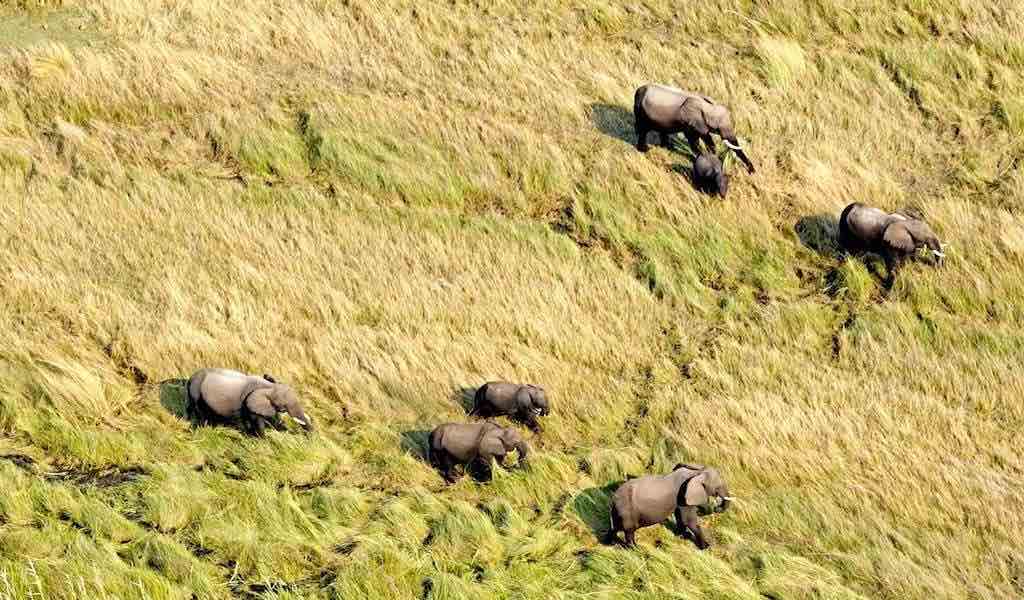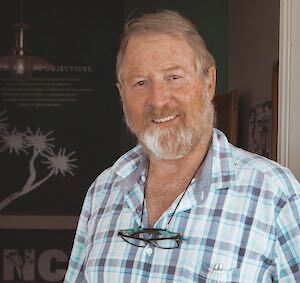
The Namibian government recently announced plans to cull 640 animals from five national parks, plus 83 elephants outside park boundaries where they come into contact with people. These plans have been met with confusion from those with little knowledge of Namibia and outrage from some within Namibia who are generally hostile to the country's wildlife policies.
The purpose of this article is to examine the facts of the matter and put this decision into context with how wildlife is managed generally and what a severe drought entails for rural Namibians. Once you see the big picture, you will understand why the Namibian Chamber of Environment (NCE, with a membership of over 80 conservation organisations) does not oppose the Ministry of Environment, Forestry and Tourism's (MEFT) plan. Instead, NCE opposes the spreading of misinformation on this topic in the international media.
Severe drought and human needs
The 2023/24 rainfall season was exceptionally poor, triggering Namibia's worst drought in 100 years. Most crops in the north-eastern parts of the country have failed entirely, creating severe food insecurity in those regions. The more livestock-reliant communities in the drier western parts of the country are slightly more resilient to drought than crop farmers, but this terrible season comes on the heels of many other droughts (e.g. 2022/23, 2020/21, 2019/20 and 2018/19) from which this area is yet to recover.

The consequences of poor rains in the early parts of the year only start to grip later in the year as the dry season wears on. An estimated 1.4 million people in Namibia, nearly half of the national population, are considered to be in a state of food crisis in July-September 2024, according to an Integrated Food Security Phase Classification report. By October, the situation will be even worse. Unless rains come early this year, many people will face starvation.
Critics have downplayed the drought and chose rather to focus on this November's national elections as the reason for the cull. All government decisions are ultimately political, but the idea that SWAPO (the ruling party) could exaggerate the impacts of a 100-year record drought in time for their election is far-fetched, to say the least. Indeed, the political situation in Namibia would be more comfortable for SWAPO if these were times of plenty and economic prosperity.
Normal wildlife management practices in Namibia

Namibia's wildlife population extends far beyond its national parks to include areas on communal lands, private wildlife reserves, hunting ranches and mixed livestock and wildlife farmlands. Most of the national parks in Namibia are fenced, in whole or part, while all of the private (freehold) reserves and ranches are fenced to keep wildlife on those properties. While fences are useful for reducing conflict with livestock-farming neighbours and reducing poaching, they prevent wildlife migration, which is particularly problematic during times of drought.
Natural population growth within fenced areas needs to be controlled, which all freehold farmers do annually, selling about 15% of their antelope to meat hunters. During drought years, the vegetation (whether grass or woody plants) cannot sustain the normal population of grazing and browsing wildlife. If this fenced system were ‘left to nature' many animals would die of starvation after causing extensive damage to the natural vegetation, which would then be slow to recover.
On purely ecological grounds, wildlife managers respond to drought by increasing the offtake rates to either keep the population growth at zero or reduce it (natural reproduction rates vary from 20-30%), depending on the state of the vegetation. This strategy reduces the impact on vegetation during the drought year and allows for quick recoveries if the next year's rainy season is better.
While culling is necessary, many farmers advertise 'cull hunts' on their properties that offer potential hunting clients the chance to hunt some of these animals, thus generating income besides meat. This kind of hunting is to be distinguished from trophy hunting, which aims to take a small number of male animals that are old enough to have bred several times. Trophy hunts are more expensive than cull hunts and are designed to have minimal or no impact on population growth.
Larger areas of land that have fewer fences and more predators do not require the same level of annual offtakes than the smaller freehold properties do. National parks the size of Etosha, for example, allow for some migration within the park, while lions and other predators will kill more prey species during a drought year as they get weaker. Nonetheless, the smaller national parks, particularly in the north-eastern parts of the country, have to be managed more intensively than Etosha and other large parks. Hunting concession areas already exist in several parks, which serve the dual purpose of managing wildlife populations and providing income and meat to neighbouring communities and MEFT.
Communal conservancies are unfenced, which allow many wildlife species to move through them between national parks. In these cases, wildlife management needs to take into account other land uses (mainly livestock and crop farming) and the needs of the people who established each conservancy. The impetus for creating communal conservancies in the first place was to allow people living on communal land to use their wildlife in similar ways to the freehold farmers in other parts of the country. Consequently, regular hunting quotas are set in conservancies based on wildlife monitoring data.
The overall wildlife population in Namibia is between 2.5-3 million animals, 80% of which are on fenced freehold farms. This means that each year in Namibia, 300,000-360,000 wild animals are killed for their meat, with more being taken off during drought years as part of normal ecological management practices.
These numbers put the culling of 640 game animals (excluding elephants) by MEFT into perspective. None these will be trophy hunted, since the aim of the operation is to supply meat to local communities and reduce local wildlife populations for ecological reasons. Hippos – which are on MEFT's list – are especially affected by severe drought, as pools of standing water are critical for their survival. When these pools dry up, hippos either move to other pools (where possible), kill each other in increasingly desperate territorial fights, or die when they get stuck in the sun-baked mud. Culling is a merciful option for hippos during an extreme drought.

Hunting wild animals for the purposes of ecological management and generating meat, income and wider benefits is therefore part of Namibia's long-term conservation and wildlife management strategy. It is embedded in many of the nation's policies, which take their cue from the Constitution that expressly supports the sustainable use of natural resources for the benefit of all Namibians.
What about the elephants?
The plans for elephant hunting are explained separately to the plans for culling other wildlife, as per the MEFT press release. It is clear that the elephants selected for this cull will be from areas outside the national parks on either communal or freehold land. In terms of numbers, taking 83 elephants from a national population of 24,000 is certainly sustainable.
The areas mentioned in the press release include places that were previously marked as human-elephant conflict hotspots in MEFT's An Overview of Elephant Conservation and Management in Namibia
that accompanied the National Elephant Conservation and Management Plan 2021/2022-2030/2031. Four of these hotspots were source populations for the Namibian elephant auction, which aimed to reduce these populations through live capture and sale. Only 37 of the 170 auctioned elephants were captured and sold from only two of the four conflict hotspots. The cull is therefore a continuation of MEFT's commitment to reduce elephant populations in these and other hotspot areas.
Like hunting for other game species, elephant hunting (and eating) is not unusual in Namibia, particularly in communal conservancies. The only difference related to this drought is that the quota for elephants was increased in certain conservancies and quotas were given to farmers on freehold land that have formed their own Elephant Management Committees.
Concerns have been raised that some of the 83 elephants will be taken from the small sub-population occurring in the far western hyper-arid parts of the country. These ‘desert adapted’ elephants are not genetically distinct from normal elephants, but their knowledge of this arid environment is essential for their survival. These populations also grow extremely slowly due to the sub-optimal conditions for raising calves.
For these reasons, and because they are more valuable for their ecological services and to support tourism, the NCE believes they should be given a high level of protection. We understand that none of these elephants are earmarked for culling. In areas that come close to the desert environment (five from Omatjete and four from Kalkfeld) MEFT will work with Elephant Human Relations Aid (EHRA) to avoid culling elephants that are part of their long-term monitoring project.

Besides the meat, any income generated from elephant hunts will go to the relevant conservancy or Elephant Management Committee (consisting of local freehold farmers) as an incentive to continue living with elephants on their land. Hunting outfitters will be able to advertise these hunts to potential clients, with non-trophy hunts provided at a lower cost than trophy hunts. According to a source at MEFT, only eight of the 83 elephant hunts are trophy hunts. None of the income from either kind of hunt will go to government coffers.
Misinformation in the media
Several pieces of misinformation have been shared with the press, many of which are on show in an article written by Don Pinnock for the Daily Maverick on 1 September 2024. Some of these errors are so obvious that they can only be attributed to the author's bias against Namibia's general sustainable use policies.
First, a table of wildlife numbers counted in the north-western communal conservancy areas is displayed to presumably show that there are not enough animals for the proposed cull. Three species are highlighted in the table because of their recent declines: gemsbok, kudu and springbok. That none of these species are even mentioned in the MEFT press release, and that no antelope species will be culled in this area, is conveniently ignored.
Second, Pinnock claims that one reason that MEFT gives for the cull is competition between the game to be culled inside national parks and livestock outside national parks. As explained above, and is clear from the MEFT press release, the issue is a lack of grazing and water inside parks (generally in the absence of livestock) and human-elephant conflict outside parks over scarce water resources. Livestock is never mentioned in the MEFT press release, so this statement was pure fabrication.
Third, the article tries to generate fear in its readers that this cull is creating a precedent that will be followed by carte blanche animal killing in Namibia and among its neighbours. This ignores the fact that Namibia's Constitution, policies and practice have involved the sustainable use of wildlife throughout the country for many decades. Most of Namibia's neighbours already allow hunting and some have suggested elephant culls in the past, so it is difficult to see how this decision will change policies in those countries.
Fourth, Pinnock quotes Adam Cruise – a well-known opponent of Namibia's community conservation programme – claiming that tourists will boycott Namibia for this cull. The only people who are damaging Namibia's tourism industry are those who are trying to manufacture international outrage over the audacity of an African country to help itself in a time of crisis rather than waiting for handouts from developed countries. African leaders are being treated like children who need permission from their former colonists before they can use their own resources. Such an attitude belongs in the dustbin of history.
Finally, Izak Smit goes out on a limb to claim that MEFT is acting on instructions from the American hunting association Safari Club International (SCI). The evidence for this claim is that SCI attended the African Wildlife Consultative Forum in October 2023, hosted by MEFT – a meeting that Smit did not attend. The meeting was held before the 2023/24 rainy season had even begun, so it is difficult to imagine that they discussed a cull (not trophy hunting) in national parks because of a future drought! MEFT does not require instructions from hunting associations to make decisions about wildlife in the national parks that are entrusted to it.
Conclusion

The severity of the current drought requires action, regardless of whether such action is politically expedient or not. Culling antelope during a drought is a common practice in Namibia that involves thousands of animals on freehold land, dwarfing the modest number that will be taken from national parks for drought relief. The elephant hunts outside the national parks will directly benefit farming communities that have borne the brunt of human-elephant conflict for many years, conflict that is likely to intensify as drought conditions worsen.
Namibia's sustainable use policies may not be popular among animal protectionists, but they are successful in terms of conservation. It is only right that Namibian people should reap some benefit from their collective investment in wildlife conservation. Spreading misinformation in an attempt to sabotage the country's tourism industry in a time of crisis reveals the true colonial colours of Namibia's opponents.
The NCE and our members stand ready to help Namibia cope with the current drought and prepare for future droughts that are likely to occur due to climate change. We believe that the sustainable use of wildlife will play a key role in helping Namibia adapt to a hotter, drier climate and should therefore be fully supported by all true conservationists.
If you enjoyed this page, then you might also like:



For articles on similar topics, please click one of the following options:

Dr. Chris Brown, ecologist, and environmental scientist, has over thirty-five years' practical experience in environmental management and administration, strategic planning and development, project and programme design and coordination. Previously he was Head of the Namibia Directorate of Environmental Affairs (DEA) in the Ministry of Environment and Tourism and played a key role in drafting the environmental clauses in the Namibian Constitution. He was the Executive Director of the Namibia Nature Foundation for 12 years. He serves on several boards including that of Namibia's Sustainable Development Advisory Council, and is CEO of the Namibian Chamber of Environment.
Dr. Chris Brown, ecologist, and environmental scientist, has over thirty-five years' practical experience in environmental management and administration, strategic planning and development, project and programme design and coordination. Previously he was Head of the Namibia Directorate of Environmental Affairs (DEA) in the Ministry of Environment and Tourism and played a key role in drafting the environmental clauses in the Namibian Constitution. He was the Executive Director of the Namibia Nature Foundation for 12 years. He serves on several boards including that of Namibia's Sustainable Development Advisory Council, and is CEO of the Namibian Chamber of Environment.

Gail C. Thomson is a carnivore conservationist who has worked in South Africa, Namibia and Botswana on human-carnivore conflict, community conservation and wildlife monitoring. She is interested in promoting clear public communication of science and conservation efforts in southern Africa.
Gail C. Thomson is a carnivore conservationist who has worked in South Africa, Namibia and Botswana on human-carnivore conflict, community conservation and wildlife monitoring. She is interested in promoting clear public communication of science and conservation efforts in southern Africa.
We use cookies to monitor site usage and to help improve it. See our Privacy Policy for details. By continuing to use the site, you acknowledge acceptance of our policy.